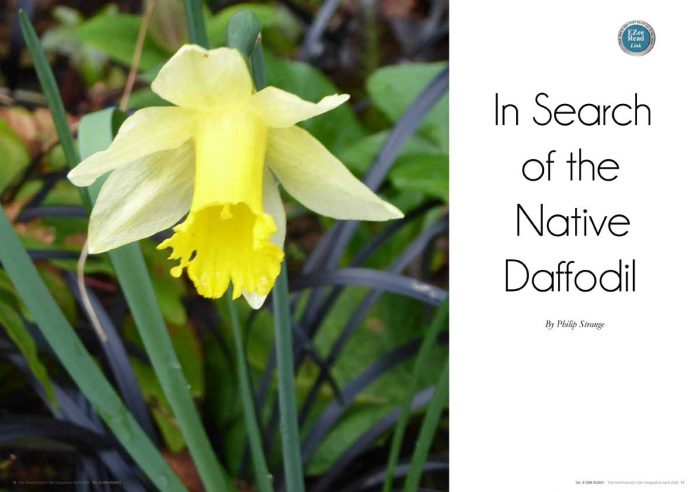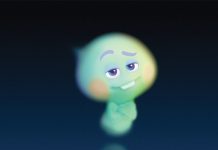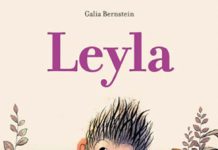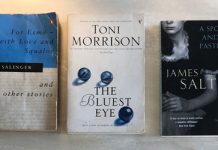This year sees the 250th anniversary of the birth of the English romantic poet William Wordsworth. One of his most famous poems, Daffodils was inspired by an extensive drift of the flowers he encountered growing along the shores of Ullswater in the Lake District.
Wordsworth’s flowers would have been our native wild daffodil, smaller and less showy than the many brightly coloured, cultivated varieties we are accustomed to seeing in our gardens and parks. Native daffodils used to grow prolifically in the wild in many parts of the UK but woodland clearance and ploughing of meadows reduced their numbers. The west country is still a good place to see the flowers in the wild so I went off to look for them in Devon and Dorset.
I started my quest in our Devon garden where, a few years ago, we planted native daffodil bulbs obtained from a reputable supplier. This year they began to flower in late February revealing blooms of an understated beauty compared to their less subtle cultivated cousins. The trumpet is lemon-yellow and rather narrow with roughly parallel sides and the six petals are the colour of clotted cream, standing perpendicular to the trumpet, like an Elizabethan ruff. The grey green strap-like leaves and flower stem holding its single flower are about 20cm long, quite a bit shorter than many cultivated varieties.
The native daffodil is a member of the narcissus family, a genus often said to be named from the Greek myth whereby the young man, Narcissus, falls in love with his reflection seen in a pool of water. Unable to resist the allure of his own image, in time he realises his love cannot be reciprocated and he wastes away turning into a gold and white flower. Others believe the name comes from the Latin word narce, (numbness, torpor) a reference to the narcotic properties of the plant. Daffodils contain many chemicals, some of which were probably responsible for these narcotic effects, and extracts of daffodil have historically been used in folk medicine. The plant is now considered to be poisonous but one compound, galantamine, is purified from daffodils grown commercially in Wales for use as a therapy in Alzheimer’s disease.
The flowers growing in our garden provided me with a useful image to keep in my mind when I went into the countryside searching for native daffodils. It wasn’t difficult to find flowers along lane-side verges in West Dorset and in Devon that resembled the native daffodil, but how could I be sure? Simon Harrap in his beautifully illustrated book “Wild Flowers” warns against identifying roadside blooms as native because of the practice of garden dumping and of hybridisation with one of the thousands of garden cultivars, some of which have been deliberately planted to brighten up the countryside. He suggests searching in deciduous woodland or old pasture where the flowers may have been long established.
So, where can we go to see our native daffodil growing in the wild? The Lake District has strong populations with Wordsworth’s flowers still gracing the shores of Ullswater in late March and early April. Another fine population can be seen near Farndale in North Yorkshire but it is on the Gloucestershire/Herefordshire borders that one of the most impressive displays occurs each spring. The “Golden Triangle”, defined by the villages of Kempley, Oxenhall and Dymock, has for many years attracted large numbers of visitors to see the carpets of wild daffodils in woodlands, orchards and pasture.
A fine display of the wildflowers can, however, be found nearer to home. Just a few miles to the west of Exeter in the Teign Valley in Devon lies Dunsford Nature Reserve and on a beautifully sunny mid-March day, we went to see the Dunsford daffodils. We parked near Steps Bridge where the Teign cascaded noisily over rocks creating showers of white water and sparkling light. The riverside path took us away from the bridge and almost immediately we came across daffodils. They were easy to find: growing under the trees in deciduous woodland, scattered across riverside meadows and flourishing among coppiced hazel stools. They were unmistakeably our native daffodil based on their stature, the shape of the flowers and their lemon and cream colour and, something I hadn’t noticed before, the tendency of individual flowers to be held at a slight angle downwards. For the most part, they do not grow thickly, it’s as though they need their space, and dense drifts of the flowers are rarely seen here. But this is compensated for by the sheer number of flowers so that for a few weeks at this time of year they own the land and it becomes very much daffodil territory. This is one of the strong impressions I shall take away from our visit.
We did find one meadow with denser growth where the colours of the flowers tended to merge into a sheen of yellow, shining like the sun and reminding us that spring is on its way. Native daffodils are sometimes also called “Lent lilies” as they were said to bloom and fade between Ash Wednesday and Easter. When we visited Dunsford on March 16th, the flowers were close to their peak but they should still be around for a few more weeks.
But let’s go back to that stormy day in April 1802 when William Wordsworth and his sister Dorothy encountered the profusion of daffodils by Ullswater. Dorothy described in her journal for April 15th how the flowers “tossed and reeled and danced, and seemed as if they verily laughed with the wind, that blew upon them over the lake”. William composed his poem two years later, inspired by her journal entry and his tribute to the daffodil has become one of the best-known pieces of verse in the English language.
Here is the last verse where Wordsworth remembers the events:
For oft, when on my couch I lie
In vacant or in pensive mood,
They flash upon that inward eye
Which is the bliss of solitude;
And then my heart with pleasure fills,
And dances with the daffodils.
For directions to Dunsford Nature Reserve look at: https://www.devonwildlifetrust.org/nature-reserves/dunsford
I bought native daffodil bulbs from https://www.wildflowershop.co.uk/index.html
Philip Strange is Emeritus Professor of Pharmacology at the University of Reading. He writes about science and about nature with a particular focus on how science fits into society. His work may be read at http://philipstrange.wordpress.com/










